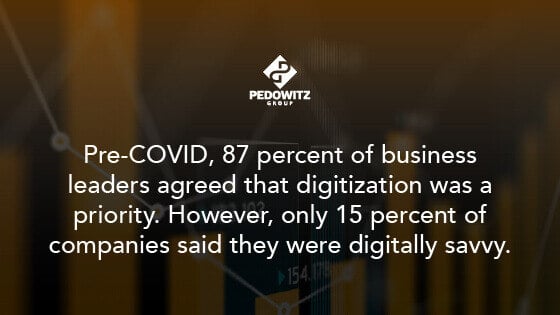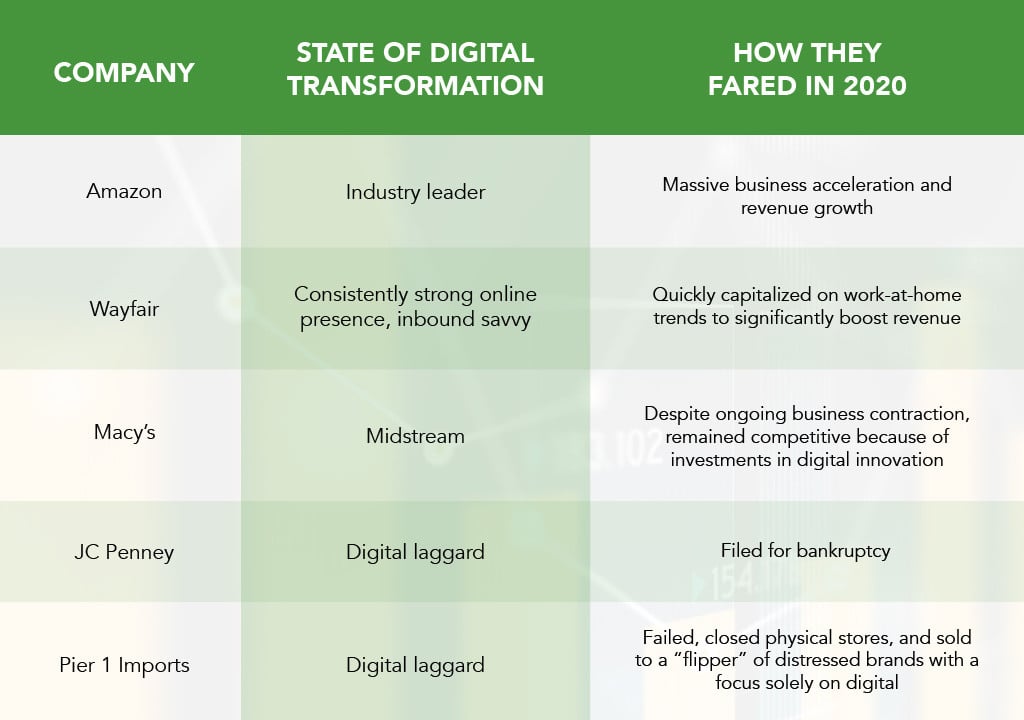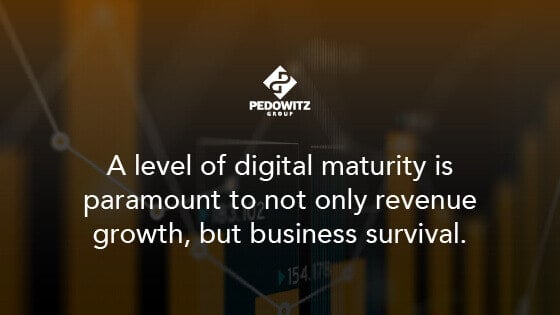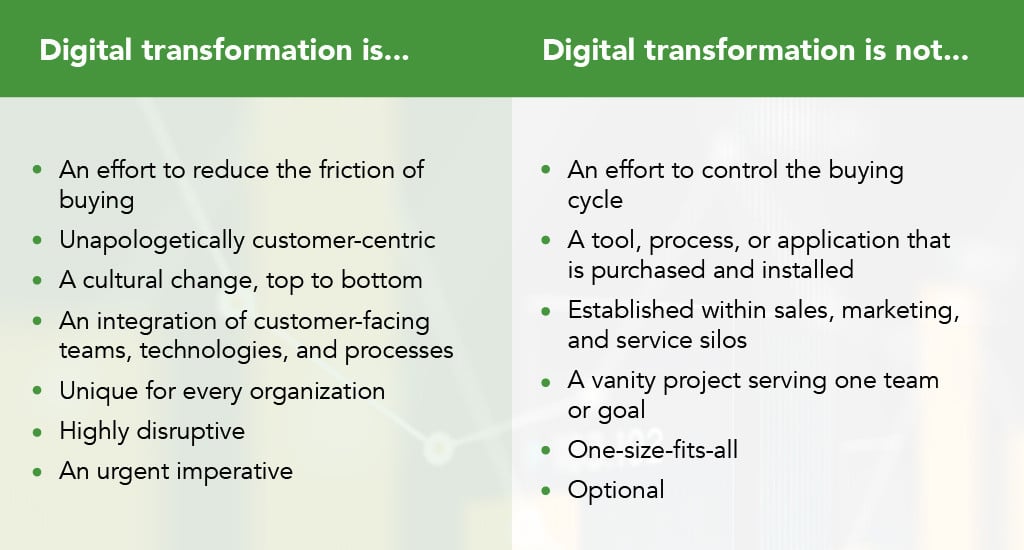Business trends come and go. When buzzworthy concepts are pounded into our collective conscience like a jackhammer – whether it’s “business agility” or “the new normal” – it’s easy to brush them aside and stay the course.
Digital transformation, however, is more than a trend. It’s an urgent imperative that is separating the winners from the losers. But what is it?
Simply put, digital transformation involves the use of technology to change how an organization conducts business. Let’s look at a few definitions:
MIT Sloan Management Review defines digital transformation as adapting to digital market trends. It can be as straightforward as automating a manual task or as complex as establishing an entirely new operating model. Regardless of scope and scale, digital transformation is intended to reduce the friction of buying for customers, which drives revenue and growth for the business.
The Harvard Business Review breaks digital transformation down into four areas, which all boil down into one, a top-down non-siloed culture where CMOs collaborate with CIOs to drive the corporate-wide goals of increased revenues, improved sales figures, and a better customer experience.
- Technology – The latest and greatest marketing technologies are only worth the money you spend on them if your organization's culture has the technological drive and expertise to integrate it with existing systems. In other words, a CMO might covet all the bells and whistles of the newest CRM or customer interface, but without the infrastructure to support it, it's useless
- Data – CMOs might not carry the official title of data scientists, but one might argue that they were the original corporate data analysts. A CMO wants to learn everything they can about their customers, competitors, and trends, and for that, they need data
However way defined, digital transformation is highly effective for revenue growth. And as we saw in the 2020 pandemic, it was not only a growth factor, but it was also a lifeline for businesses to survive.
New: The Revenue Operations Report
The Pandemic Accelerant
In early 2020, the world was blindsided by the deadliest pandemic in a century. The COVID-19 pandemic devastated our world in more ways than we can count. However, if there's a single silver lining in the volatile storm cloud, it's that thanks to digital business technologies, society found a way to function, despite global lockdowns.

Pre-COVID, 87 percent of business leaders agreed that digitization was a priority. However, only 15 percent of companies said they were digitally savvy. Moreover, 67 percent said that if they didn't change their focus to digital by 2020, they would fail to remain competitive.
They were right, but perhaps not for the reasons they thought.
If the pandemic taught us anything, it's that future-proofing should have happened in the past. Within six months of the start of the pandemic, digitally mature companies' valuations soared by 23 percent. The least digitally mature companies saw their valuations rise by just 7 percent.
As consumers are conducting more online business, so are companies. The crisis accelerated digital transformation adoption by three years. Today, organizations are three times more likely to say that at least 80 percent of their interactions with customers are digital.
(One could also argue this has spurred so many mergers and acqusitions in a quest to achieve more revenue growth)
We’ve all seen how digitization can make or break businesses, consider the recent performance of the following retailers:

Digital Transformation and Digital Maturity
Not all digital transformation is created equal. As seen in the example retailers above, a level of digital maturity is paramount to not only revenue growth, but business survival. Digital maturity is a gradual process that provides the tools to help businesses navigate the future. Or, to put it more simply, or perhaps too simply, digital transformation is reactive while digital maturity is proactive.
That's not to say that digital transformation is short-sighted. Technology is the foundation of digital transformation (although it takes much more than tech). Let’s look at an example of digital transformation without digital maturity:
Your CRM streamlines the sales funnel and enhances the process for both buyers and sellers. And because most CRMs are usually cloud-based and require little to no enterprise-level hardware, agility and resilience are built-in. Your sales team is able to work in real time with customer and pipeline data, creating efficiencies in the selling process. Still, using a CRM doesn't make a company digitally mature.
Moving beyond the CRM, perhaps your marketing department might use a marketing automation platform while your sales department uses a CRM. If each platform is siloed and not integrated with each other, you’ve got more problems than efficiencies. Sure, both necessary parts of a digital transformation and customer centricity, but as siloes they impede essential collaboration without an integration plan.
(Now image this scenario, but with tech for sales enablement, intent data, chatbots, data enrichment, and much more being shared (or at least, interacted with) between the teams. No wonder companies struggle!)
Digital maturity is holistic. Deloitte describes five dimensions that indicate digital maturity:
- Customer experience – is your company communicating with customers on their preferred channels? Are customers happy with their user experiences?
- Strategy – Using technology to increase the competitive advantage and create a business strategy
- Technology – Managing data in a way that benefits both the customer and the company
- Operations – Enhancing business effectiveness, delivery, and efficiency through digital technologies
- Organization and culture – Developing a top-down organizational culture with the talent and support needed to achieve digital maturity. This should include ongoing reskilling and coaching
Related: Our sales and marketing tech consulting services bring a lot of unity!
In most cases, digital maturity is organization wide. In some cases, however, the term can be applied to individual silos within an organization. For example, a marketing department that meets Deloitte's criteria might qualify as digitally mature…but that is not enough for successful transformation.

The correlation between digital maturity and business performance has never been more obvious. And it’s become more imperative in the aftermath of a global pandemic that further separated the digital vanguards from the digital dinosaurs. In almost every case, the companies that performed well in 2020 had strong digital capabilities, and those that failed did not.
There are countless companies lingering in the middle, and their future viability hinges in large part on their ability to advance and maximize their digital strategies. A growing majority tend to agree.
The foot-dragging of the past has quickly given way to rising urgency.
How To Approach Transformation
While adopting a digital transformation falls under the purview of IT departments, the main goals of digitizing an organization are to improve the customer experience and increase sales or growth. Therefore, marketing is crucial for digital transformation and why CMOs and CIOs are increasing collaborating between the two functions.

All too often, organizations turn to their CIO to manage their digital transformation. While that does seem logical, it represents old thinking. Sure, CIOs have the technical know-how to explain what will and won't work with the existing architecture. And, of course, they are ultimately the people responsible for the logistical side of the transformation.
However, asking a CIO to make all the digital transformation decisions is like asking a mechanic to make all the car purchasing decisions for you. Odds are, the mechanic will find you a good car, but will the car suit your needs? Does it have the seating and cargo capacity you need? Will it drive far enough on a single tank of gas or electrical charge? Do you like the looks, the color, and the car's features?
Ideally, your mechanic should be involved in the buying process, but since you're the primary user, it's up to you to specify the parameters you need. It's the same with a digital transformation. A company's marketing department should collaborate and even lead every step along the way.
Why marketing should be the key driver of digital transformation
Marketing teams have been using technology tools to transform customer-facing activities – including lead, campaign, and content management, to name a few – since the mid-2000s. Along with a growing wealth of online information and resources, these activities accelerated the shift from sales-driven interactions to customer-driven experiences.
Customers are now doing their own research, making their own decisions, and completing their own buying cycle with little or no involvement from a sales team. And COVID-19 ground traditional activities like sales meetings, presentations, conferences, and trade shows to a halt.
The pandemic will subside, but we’re putting these stakes in the ground: The old way of conducting business will never come back. Customer engagements and experiences will remain almost entirely online. And the organizations that haven’t already transformed will need to catch up quickly.

But it will require more than technology. And that’s where most companies get it wrong.
Too often, organizations operate under the false premise that digital transformation can be purchased and installed. But it requires sweeping cultural changes – in addition to the right set of tools – that begin with a new mindset and greater cross-functional collaboration.
Ultimately, digital transformation is about creating new ways of engaging customers and conducting business. Regardless of the tools employed, this can’t be achieved with a “legacy” mindset. Operational silos must be broken down, new processes must be engineered, and all customer-facing teams must work in lockstep to improve the end-to-end buying experience.
What happens when “legacy” mindsets persist?
Marketing teams remain laser-focused on attracting new customers and earning more revenue from existing customers. Sales teams continue to sell in traditional ways, despite their decreased influence over the buying cycle. Neither side has visibility of what the other is doing. Technology investments and processes remain splintered. And the end result is a disconnected, incongruent customer experience that limits revenue and growth success.
Change is difficult, especially when divergent personalities, agendas, and measurement criteria are involved. That’s why proactive change management – stemming from the highest levels of a company down to each customer-facing team – is so vital for successful digital transformation.

Establishing a proactive, cross-functional, customer-centric approach
While digital transformation should never be confined to a single department, it often starts with the marketing team. In addition to being early adopters of customer-facing technologies, marketing has an unprecedented view of the buyer journey and a unique ability to influence it.
With guidance from upper management and collaboration with their peers in sales and service, marketing leaders will need to invest in the right tools and create the right strategies and processes to maximize those tools. Equally important are the mindset and cultural changes that will be necessary to achieve the desired outcomes.
Marketing will need to lead that change to be successful.
Revenue Marketing Fuels Digital Transformation
We have talked about the four stages of revenue marketing many times within this blog which include: traditional marketing, lead generation, demand generation and revenue marketing.

Digital transformation is the foundation of revenue marketing. It accelerates customer centricity and it allows for marketers to take revenue accountability, transformation marketing from a cost center to a revenue center.
Revenue marketing means complete culture change. Instead of leads, the focus is on obtaining quality leads with high conversion rates. A revenue focus may not de-silo an organization, but it will put the two departments that are most directly tied to growth on the same team.
Related: Our revenue operations consulting services
Success Factors to Keep in Mind
Marketers who transform their businesses do so with five major areas in mind. They do not merely add a new ingredient to the mix, they overhaul the menu. This means clearly articulating your vision, purpose, and direction with total transparency: Why you are taking on this transformation, what you need to do to make it happen, and how you and your team intend to do it all must be defined up front and communicated often.
Hallmarks of a successful approach look like this:
Strategy Obsessed
Strategy Obsessed Single-minded, unapologetic, and intense. These organizations are preoccupied with strategy and disciplined enough to drive it at every step of their process. They ingest a steady diet of top-quality thinking and meaningfully interpreted data to shape strategy that reflects a sophisticated worldview with depth and comprehensiveness.
Remarkable people with epic leadership to guide them
Our epic leaders need to be empowered to drive change in the organization, which means that they will need executive support to hold people accountable for new behaviors.
In addition, the leaders need to know what skills they have to work with. We have found that a lack of clarity around what roles are needed and what responsibilities need to be covered creates total havoc on an organization.

Once the strategy is clear and executive leadership has determined the course of action, a careful assessment of what skills you have already and what skills you will need is in order. So often we hear turmoil and even voluntary attrition because people don’t know what is coming and what it means for them.
You can get ahead of that with careful planning and complete transparency in communication as to why, what, and how you will make changes to your business.
Process Orienteers
Implementing any new strategy and technology inevitably means that new processes must be created or re-engineered, and people will need to learn them. This will have a ripple effect, sometimes vibrating through organizations at significantly disruptive wavelengths. Planning for this means cross-functional collaboration and education planning, as well as executive agreement to hold people accountable for new behaviors.
A few key processes that need to be considered are program planning, lead management, and data management.
Customer Casanova
A substantial shift towards obsessing about customer behavior, what it’s telling us, and what we can do to engage them more effectively. With our digital binoculars, we can now see so much more of our customer’s behaviors, all of which we need to catalogue and leverage for strategic advantage.
Successful organizations woo their customers and engage them at every turn. They are intensely interested in them because they know relevance is key to successful customer engagement. People in buying groups want to feel like you know what they want and need.
If you miss the mark, they’ll ignore you. Miss the mark repeatedly, you'll be shut out.
To be relevant, you need to talk about them, not your products or solutions. You need to talk to them about their problems and their business challenges. And to stand out, you need to teach them about their business.
Technologeprenuer:
Implementation of new technologies that support the strategic direction of the organization as a whole and for Sales. Note that implementation alone isn’t enough to get us where we need to be in terms of reporting and analytics, so these systems must be integrated and not floating out there on their own.
Of course, technology is critical to transformation, again, often the catalyst. Once you have your backbone technologies in place, staying aware of what is available in the market is key to staying connected to your customers.
To learn more about these hallmarks of success and how to influence change, check out our revenue marketing kit for full guides, change management infographics, books and more!
When and where to get help
Leveraging external consultants and establishing a Revenue Marketing Center of Excellence (CoE) can help reconcile technology resources, reform longstanding processes, and reinforce a customer-centric mindset. They can help apply new technologies to produce actionable, data-driven insights. And they can help align marketing, sales, and service teams to deliver a proactive, cross-functional buying experience for customers that stimulates business revenue and growth.

In the end, digital transformation cannot be achieved with technology alone. It requires an entirely new mindset, a shift in organizational culture, and dedicated change management to ensure “legacy” behaviors don’t persist.
There’s a good chance you already have the tools you need. Now it’s a matter of transforming your business to get the most out of them.
To learn how your marketing team can become an influential driver of digital transformation, schedule a call with one of our revenue marketing experts.